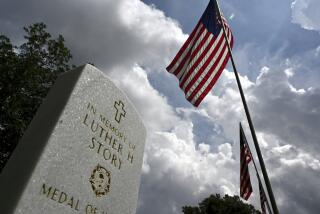MIA Mystery Solved
- Share via
As a boy, Bruce Giffin idolized his uncle Ross. Few children had a relative who could fly a jet on a moment’s notice to come visit for the weekend.
Ross Fobair was his nephew’s all-American hero. He looked like a knight in his flight suit. But he was shot down 45 miles northeast of Hanoi in 1965, the first American pilot claimed by a surface-to-air missile in the Vietnam War.
Fobair, who was 30 at the time, was listed as missing in action. He did not appear among the hundreds of American prisoners of war who returned home in 1973 during Operation Homecoming. His family’s despair was heightened when that of others was being quelled. Fobair was believed to be dead.
But rumors abounded. Squadron mates said they saw Fobair, along with his flight partner, eject from his F4 Phantom. Others told Giffin, who was 9 at the time of the crash, that his uncle could still be alive, perhaps captive in Russia where his expertise in electronics would prove invaluable to the Soviets.
Giffin needed certainty.
He got it late last year, 34 years after his uncle vanished.
Military forensic scientists told the family last December that a tooth found at the reported crash site was that of Giffin’s uncle.
Pilot to Get Full Military Honors
It was a somber yet comforting piece of news for Giffin, who documented the 1997 excavation of the crash site with a film crew. He and his mother, Betty McDermott, have organized a memorial service for April 29 in Santa Barbara, where Giffin lives. Fobair will receive full military honors, including a flyover conducted by Edwards Air Force Base.
“He was a father figure,” said Giffin, 45. “This mystery of what happened to him was a constant thing. There came the opportunity to solve the mystery, and I took it.”
Giffin’s trip to Vietnam in 1997 coincided with that of a task force responsible for investigating the fates of 1,986 Americans still unaccounted for. Created in 1992, the Joint Task Force for Accounting has closed the books on 281 missing military men and women.
For many Americans, Giffin included, returning the remains of fallen soldiers is a national duty.
“We don’t leave our dead on the battlefield,” said Lt. Col. Franklin Childress, a spokesman for the task force. “Until the remains come back and we bury them, families can’t close a chapter in their life.”
And that’s exactly what Giffin wanted to do. He said he was inspired to search for his uncle after his eldest son was born in 1990, and after renewed media attention on POWs.
Giffin spent a month in Vietnam, leaving work as a prominent building contractor and developer. The ultimate moment came on Nov. 12, 1997.
“The moment was so intense, it was a little surreal,” Giffin said of the discovery of a 1964 American penny, several zipper tabs, a 38-caliber bullet and a tooth near Fobair’s crash site.
The military experts hired local Vietnamese laborers to dig up the side of the 4,000-foot mountain. The site, with its rich greenish sprawl, was probably unchanged for centuries until Fobair’s plane crashed, Giffin said. Soil was sifted through a mesh frame as the investigators interviewed nearby villagers. Some said a pilot had been buried after the crash.
That night, exhausted, Giffin returned to a hotel in Hanoi and faxed a detailed account to his mother in Toluca Lake.
McDermott, 71, has a crate of letters, newspaper clippings, documents and photographs on her brother. She was especially close to Fobair; their father died when they were children.
Verification Brings Closure, Pain
Even after all those years, McDermott said she was overwhelmed with pain last December when she received the call from military authorities who had used dental records to confirm the tooth was Fobair’s.
“The reconciliation is that we now know for sure that the remains are his,” she said. “We know he died. Now it’s time to create closure. It’s a process. It’s not an open-and-shut thing.”
To McDermott, the memory of her brother remains.
Lt. Col. Fobair, a graduate of Covina High School, was a communications expert for the Air Force. He was the navigator the day his plane was shot down. Fobair was flying a “top cat” mission, on which his plane was a decoy to divert attacking enemy MIG fighters away from American F105 bombers during President Lyndon Johnson’s “Rolling Thunder” campaign. It was believed that Communist Vietnam could be persuaded to surrender by America’s air power.
Fobair’s pilot, Capt. Richard P. Keirn, said he saw Fobair slumped in the back seat of the Phantom with blood running from his nose after the missile struck. Keirn ejected and spent the next 7 1/2 years in captivity in the the prison dubbed the “Hanoi Hilton.”
Victim’s Only Son Died in Infancy
Fobair left behind a wife of two years, Anne Hanto, who remarried eight years later. Their only child, David, had been born prematurely and died two weeks before Fobair left for Thailand in 1963.
“I always felt bad that Ross didn’t have someone to carry on his legacy other than Betty,” Hanto, 59, said from her Tampa, Fla., home. “I’m glad Bruce got so interested in his uncle because he is Ross’ legacy.”
Giffin says he takes comfort in the fact that his uncle’s probably died quickly. But he warns that stories such as Fobair’s should serve as a reminder that a nation must understand what it is fighting for before sending off its troops.
“I’m grateful for what we have and what we got,” Giffin said. “Our family is more fortunate than 2,000 other families, because we have an answer.”
More to Read
Sign up for Essential California
The most important California stories and recommendations in your inbox every morning.
You may occasionally receive promotional content from the Los Angeles Times.














